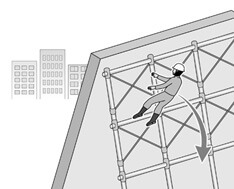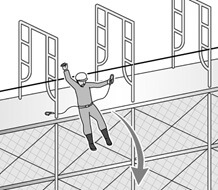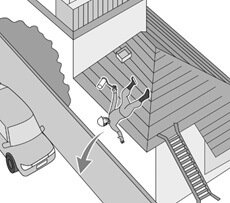[Chapter 3] Section 8 ②
3. Accident examples and countermeasures①
- [Example 1]
While working at a 13-m high location during construction of a large solar panel facility, the worker’s foot slipped from the steel frame or bridge batten of foot post on which he was standing, and he fell to the ground and died. -
[Accident situation]
Four workers were engaged in preparation work (masking) before painting the steel frame on the back side of a large solar panel structure.
While carrying out masking work at the location of an opening (115 cm) between the temporary scaffolding and the solar panel, at a height of 13m, the victim’s foot slipped from the steel frame (5cm wide) or the bridge batten of foot post (4.8 cm in diameter) on which it was placed, and he fell to the ground, and died of cerebral contusion.
[Cause]
Fall prevention measures were not taken, such as setting a fall prevention net for the working floor and having workers use fall arrest equipment. Masking work was carried out by workers putting their feet on the steel frame and the bridge battens of foot posts where they normally shouldn’t be placed.
[Countermeasures]
Take fall prevention measures, such as setting a fall prevention net under the working floor and having workers use fall arrest equipment.
Also, install a working floor to eliminate work in strained postures, such as supporting the body by placing feet on the steel frame or bridge battens of foot posts.
- [Example 2]
While scaffolding was being dismantled at a work site for large-scale repairs of an apartment building, a worker was moving on the scaffolding and fell from the scaffolding to the ground. -
[Accident situation]
The victim was carrying scaffolding members on the scaffolding, performing the job of transferring dismantled members, during scaffolding dismantling work at a work site for large-scale repairs of an apartment building. After the worker passed the scaffolding members to the worker doing unloading, he moved on the scaffolding to take the next members from the worker doing dismantling, and at that point tumbled from the scaffolding to the ground.
As he was moving on the scaffolding, there was a junction point in the main rope, and he needed to reattach the fall arrest equipment for the double lanyard system. Sunset was approaching, the site of the scaffolding dismantling work had begun to grow dark.
[Cause]
The following are possible causes of this accident.
1)The double lanyard fall arrest equipment was not used properly.
When the victim moved on the ledger board of the scaffolding and reattached the hook of the fall arrest equipment at the junction point of the main rope, he removed the hook attached to the other main rope before attaching the hook on the unused side to the main rope (on the other side of the junction), or the hook which he intended to attach was not completely attached to the main rope.2) The work was continued even though the work site was getting dark at sunset.
For this reason, it is possible that there was an increased risk of not being able to clearly see the main rope for attaching the hook of the fall arrest equipment, or of tripping over a gap in the ledger board.3) There was no dedicated watcher, and the operations chief carried out watching while engaged in work by himself.
[Countermeasures]
In order to prevent similar accidents, the following measures must be consistently implemented.
1) Consistently educate workers on proper use of double lanyard fall arrest equipment. Prior to the start of work, make it a consistent practice to have workers mutually check each other for proper usage (of double lanyard fall arrest equipment), and thereby firmly establish proper usage.
2) To ensure illumination allowing workers to see clearly around their hands and feet, do not allow work just before sunset, or else provide lighting equipment.
3) Strengthen the communication system so a watcher is always present. If it is difficult to assign a full-time watcher, assign multiple staff to act as deputies in charge.
- [Example 3]
While painting the roof of the first floor of a house, a worker lost his balance and fell to the asphalt pavement. -
[Accident situation]
While painting the first-floor tin roof of an existing wooden house using a hand tool for painting (roller), the victim fell from the roof (at a 3.13 m height) to the asphalt pavement surface of a neighboring parking lot, and died of cerebral contusion.
In this work, no fall prevention measures were taken, such as installing scaffolding, handrails, main rope, etc. on the roof to be painted or the building, etc., and the victim did not wear protective gear, such as a safety helmet or fall arrest equipment.
[Cause]
1) No fall prevention measures were taken, such as installing enclosures, handrails, covers, etc., at the work place, even though the worker was asked work at the edge of a working floor at a height of 2 m or more.
2) The worker was not asked to wear a safety helmet to prevent injury due to falling.
3) Safety education on the dangers, etc. of painting work at high places was insufficient.
[Countermeasures]
1) Take measures to prevent falling such as providing enclosures, handrails, covers, etc., at places where there is a risk of endangering workers due to a fall, at the edge of a working floor at a height of 2 m or more.
If it is especially difficult to install an enclosure, etc., take measures to prevent falls such as having workers use fall arrest equipment after installing a main rope beforehand.2) Have workers wear safety helmets to prevent injury due to falling and monitor the use of safety helmets during work.
3) For painting work, etc., at high places, consistently implement education for the involved workers regarding dangers, hazards, and necessary information relating to the work such as work procedures, etc.
受講者様のご希望に合わせ、以下のタイプの講習会もご用意しています


このページをシェアする
講習会をお探しですか?